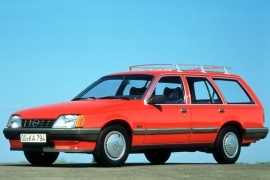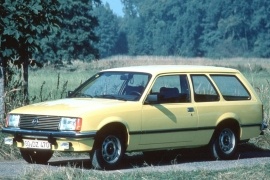OPEL Rekord Caravan Models/Series Timeline, Specifications & Photos
First production year: 1977
Engines: Gasoline, Diesel
Body style: Wagon (station wagon, estate, combi, touring)
After five years on the market, the Rekord Caravan received an update along with the rest of the range before being replaced by the Omega in 1988.
While the other carmakers started to change their lineups, Opel had to stick with the Rekord until the new generation was ready. Still, it could make some major improvements to a car that helped the carmaker survive through an oil crisis and new emission regulations. The 1982 model offered more comfort, better fuel efficiency, and, in station wagon shape, a more straightforward flat-folding rear bench.
The car received a redesigned look. At the front, the hood was extended and bent over the grille, while the headlights were raked and reshaped with a rounded inside edge. For the diesel versions, the hood received a bulge in the middle. The metallic bumpers were replaced by plastic, shaped bumpers with a lower apron in the front. The roof was extended over the trunk area at the back, and two side windows found their place behind the rear doors.
Almost half of the dashboard was bigger, with the instrument cluster and the center stack in one piece. It featured a radio cassette player and ventilation controls. As an option, the car was fitted with power windows and a sunroof. The folding rear bench expanded the trunk area up to 881 liters (31.1 cu-ft).
Another essential upgrade was for the engine compartment, where the carbureted versions were completely dropped, favoring the fuel-injected versions. There were two new gasoline engines and a 2.3-liter turbo-diesel that joined the range.
In 1977 Opel introduced the last generation of the Rekord nameplate, the E-generation, and made it available as a sedan, a station wagon named Caravan, or a three-door station wagon.
Opel created the Rekord Caravan as a vehicle suitable for taking the family on vacation and the children to school, and it was one of the most successful vehicles on the German market. Even though it carried over the drivetrain and the suspension from its predecessor, the design was far more evolved and helped the car sell in significant numbers.
The E1 model, since it was before the 1982 facelift, featured squared headlights and a black grille with horizontal slats between them. Its raked, curved windshield and smoothed corners combined with long, straight lines made the car looks more upmarket in the BMW 5-Series segment. Unlike its sedan sibling, the station wagon featured two or four doors and an extended roof behind the rear passengers. In addition, the third row of side windows was added next to the trunk area. Finally, at the back, the Caravan sported narrow, tall taillights flanking the tailgate.
Inside, Opel installed bucket seats at the front and a bench in the rear to fit five adult-sized passengers. The square-looking instrument cluster featured big dials for the speedometer and tachometer and two additional gauges for the fuel tank and the coolant temperature. The design team installed another six light bars in the middle of the instrument panel to warn the driver of low oil pressure, low battery charging, etc. The power windows and the sunroof were on the options list. At the back, the flat-folding bench could extend the trunk space when needed.
Opel took most of the engines from the previous model under the hood, the Rekord D, but the 1.7-liter version was dropped.

